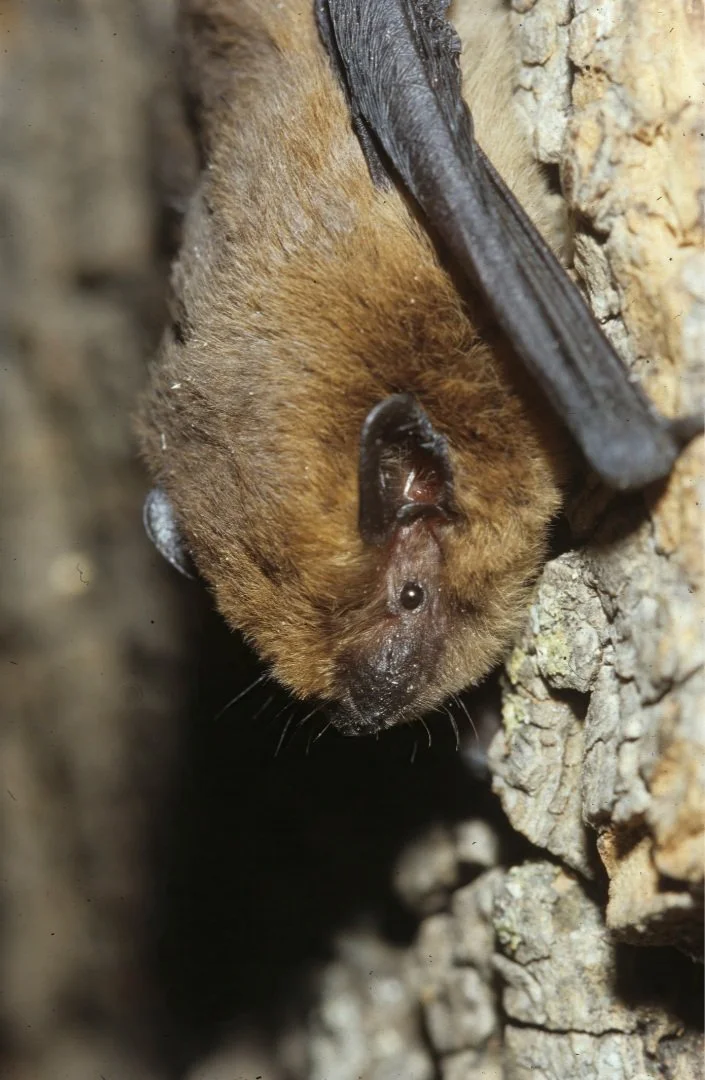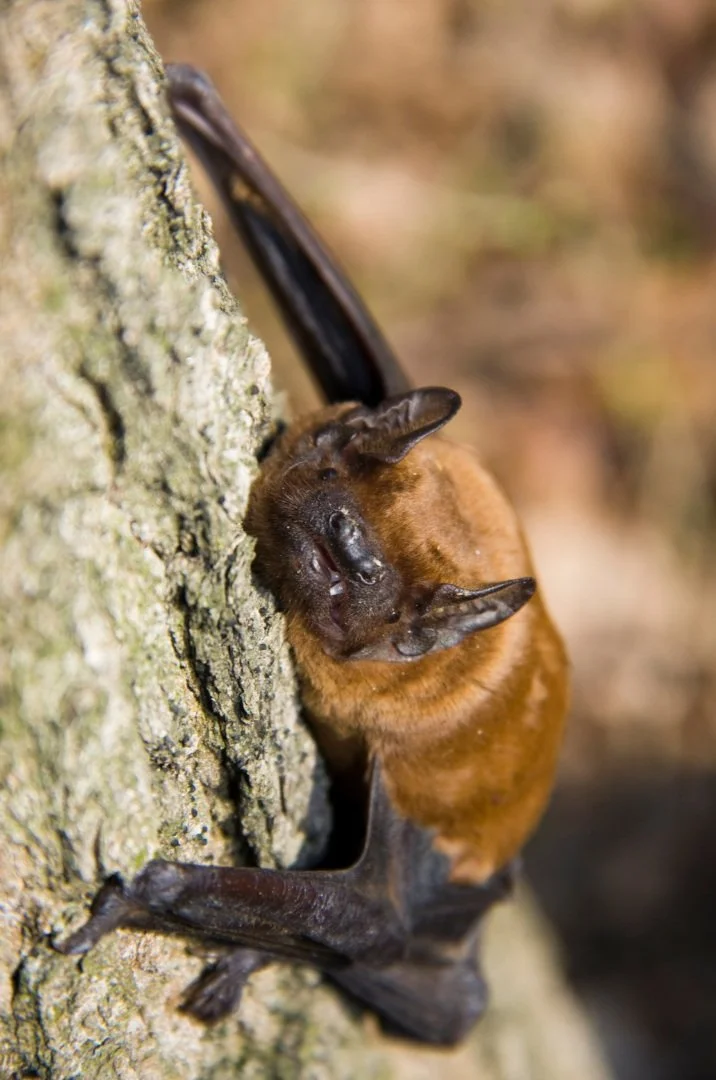Meet Scottish Bats
We don’t have jungles full of fruit bats, but we do have 10 species of bats found across Scotland! The most widespread bats on the British Isles are pipistrelles - if you’ve seen a bat fluttering in your garden at dusk, it was likely a pipistrelle hunting insects.
Generally, the further north and west you go, the fewer species you’ll encounter, but bats have been found roosting on Orkney, and even Shetland gets occasional visitors. Southern Scotland, with its milder weather, larger insect populations, and more diverse habitats have more diverse and larger bat populations.. For example, Threave Garden in Dumfries and Galloway hosts 7 different bat species, and Culzean Castle’s estate has nine of Scotland’s ten species present!
Let’s meet the bats…
Common Pipistrelle on a rock.
Soprano Pipistrelle
Pipistrellus pygmaeus
The most common bat in Scotland, Soprano pipistrelles (or ‘Soprano pips’) are often seen flying around gardens and parks on summer evenings feeding on midges and other small flying insects. They have an irregular flight pattern and can look moth-like in their movements. They are small bats weighing around 5 grams, and are the most likely to be found roosting in homes and commercial buildings. They only need a gap of 10-15mm to fit into a crevice and call it home!
Soprano pipistrelles are named for their echolocation frequency which peaks at around 55kHz, 10kHz higher than the echolocation of their cousins…
Common Pipistrelle
Pipistrellus pipistrellus
Ironically, less common than the Soprano pipistrelle, but more prevalent at the outer edges of bats ranges in Scotland. This hardy bat species have been found roosting as far north as the Orkney Isles!
They look similar to Soprano pipistrelles (both are small and brown) and while in-hand ID is possible, their calls are the primary way of telling the two apart. Common pipistrelles have a similar sounding call to Soprano pip’s, but their peak frequency is around 45kHz.
Common and Soprano pipistrelles were only identified as separate species relatively recently, with advances in technology and genetics needed to separate the two.
Nathusius’ Pipistrelle
Pipistrellus nathusii
A close relative of Common and Soprano pip’s, the Nathusius’ pipistrelle is larger and had previously been known as a migratory visitor. They would arrive in the autumn to overwinter, but in recent decades some are staying year round. In Scotland, they are still one of our rarest bats, and it’s likely only a matter of time before a confirmed maternity roost is found in Scotland.
Brown Long-Eared Bat upside down on a rock.
Brown Long-Eared Bat
Plecotus auritus
Brown long-eared bats are named for their strikingly long ears, which when unfurled are almost as long as their body. They prey on moths with rudimentary ears, so have evolved to listen for sounds made by the moths themselves. They echolocate, albeit quietly, as they navigate around woodland understories.
Brown long-eared bats like roosting in complex attics where they ‘warm up’ before leaving to feed each night. As slow but precise fliers, they are often the latest to emerge - making them difficult to see and hear on bat surveys without specialist equipment.
Daubenton’s Bat
Myotis daubentonii
Daubenton’s bats are found near rivers, canals, and lochs where they feed on insects on the surface of the water. They are true specialists in hunting over water, with larger feet than their cousins to glean their pray as they fly. Daubenton’s are often found roosting in bridges, tunnels, and other masonry close to their preferred feeding sites. If you see a bat flying close to the waters surface, it’s likely a Daubenton’s bat!
Daubenton’s bat in flight.
Natterer’s Bat
Myotis nattereri
Natter’s bats have broad wings, allowing them to fly in a range of habitats. They feed on flies, moths, and even take spiders straight from their webs! Often found in parklands, large gardens, and woodland edges they are most in southern and central Scotland. They tend to roost in old stone buildings or tree hollows.
Whiskered Bat
Myotis mystacinus
A small forest bat found only in southern Scotland, Whiskered bats are one of our rarest species. They are smaller than their more common Myotis cousins (one of the three so-called ‘Small Myotis’ bats in the UK) and favour woodland clearings, tree-lined rivers and hedgerows. They are usually confirmed to be roosting using DNA evidence from their droppings.
Brandt’s Bat
Myotis brandtii
The other ‘Small Myotis’ that makes it into the north of England, this is potentially Scotland’s 10th bat species. They are found in Cumbria and Northumberland, and it may only be a matter of time before they are confirmed north of the border.
Noctule on a tree trunk.
Noctule
Nyctalus noctula
Our largest and fastest bat, Noctules have a 33-35cm wingspan and reach speeds of 30mph. They often emerge before sunset, and feed on large beetles and high flying insects above tree lines. They have a loud, relatively low-frequency echolocation call with a ‘Chiff chaff’ like feel.
When a Noctule flies over our survey teams, they drown out all other bat calls. They are large, powerful, and loud!
Leisler’s Bat
Nyctalus leisleri
Sometimes called the ‘Lesser Noctule’, they are quite rare compared to their larger cousin. They are found in the south-west of Scotland, in Dumfries & Galloway and Ayrshire. They will sometimes dive steeply after prey and are noticeably faster than smaller bats. They are only encountered rarely, and feed on flies and moths high in woodland canopies and around pasture.
Bats in Northern England
Many species are advancing north with climate change, so who might we expect to show up in Scotland? It may take time before species beyond Brandt’s are found this far north, as other species in the UK are only found further south in England and Wales. Charismatic species like Serotine or the two horseshoe bat species are still a long way from reaching the north of England!
If you need a bat survey (or think you might) get in touch with our team of specialist ecologists!
Or read more of our latest blogs:








